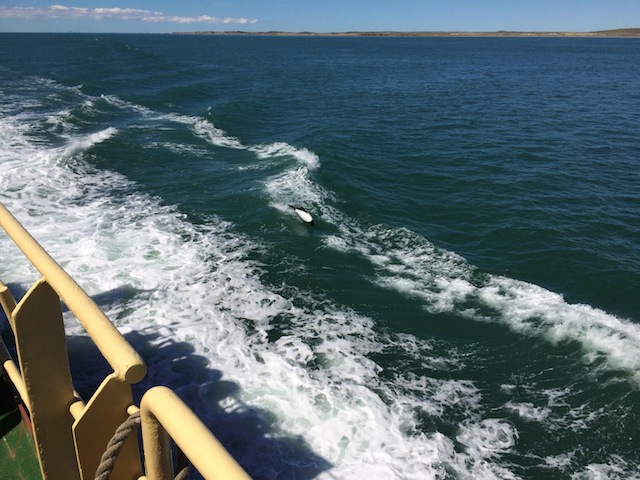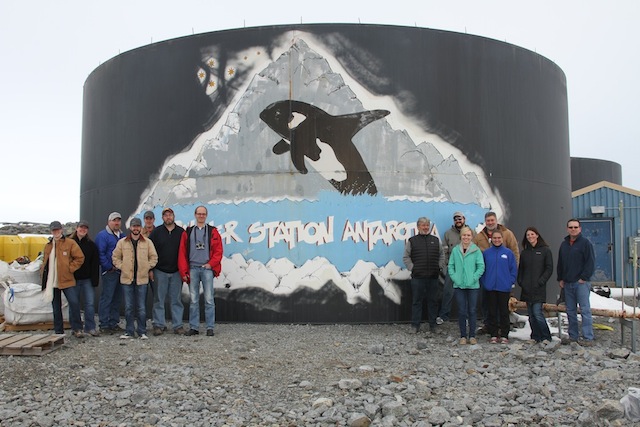Icy Inverts Cruise 2013 - Shipboard Blog - Dec 19th
(END OF THE CRUISE)

19 Dec 2013 - Straits of Magellan (520 28.4` S 690 32.6` W)
We have made excellent time on the way back to Punta Arenas and are in the Straits of Magellan now (see above image); ships always seem to make better time on the way back to port. In fact, we will dock about 12 hours early, meaning we will get into Punta Arenas around 10 PM tonight. Thus, this will be the last blog post for the trip. In wrapping up, there are many people to thank for such a successful cruise (really 2 cruises). The level of logical support provided by ECO (boats crew) and ASC (Antarctic support) has been amazing. We could not have completed this work with out them! All the scientific participants of the cruise have been “Dyn-o-mite” (said in a “Runrun” voice for those of you old enough to remember that show) and have worked hard long hard hours (see below image). Also, thanks to Scott Santos whom has been posting the blogs on a daily basis!
The main task tomorrow morning will be to get the samples off the ship and ready for transport back to the USA. We have most of the samples packed already. We have 2 medium tri-wall boxes (roughly 4 ft x 4 ft x 4ft) filled with ethanol and formalin fixed samples, as well as 15 large coolers of frozen samples. Because of the holidays, these will be held in a Punta Arenas warehouse until after the New Year’s holiday. Once all the samples are dealt with, we will finish cleaning up and then have a cruise dinner tomorrow evening as a final wrap up. Most of us will start flying home this Saturday, the 21st of December.
When we reached Palmer, and I am sure it will be the same once we get back home, a common question was, “Were your objectives met on the cruise?” This is actually a very difficult question to answer. On one hand the answer is clearly “No.” The objective of the cruise was to sample in the Bellingshausen Sea and we did not even come close to our target region because of the ice. One the other hand, we were able to adapt, and explore the Weddell Sea and several of the fjords along the Peninsula. On this front, we did very well and there is no doubt that a lot of good science will come from this cruise. We discovered several new species, including bizarre parasites, bone eating worms, an odd sea spider, aplacophoran mollusks, and several leeches. We also have novel data on how sea spiders walk, samples for genomics and neurobiology, and sediment for looking at meiofauna (small animals living between the sand grains). To a layperson, some of this may sound obscure, but when taken together, it will help us address important questions about biodiversity and population genetics in the Antarctic. This will help us understand how things like global climate change impact this rapidly warming area.
I will also get questions like “But what about all the ice? Ice, in more typical years, is not nearly so prevalent on this part of the Antarctic Peninsula. “Wouldn’t that suggest global climate change is not so bad in the Antarctic?” Well, ecosystems are complex and there is very clear evidence that the Western Antarctic is becoming warmer, both for the sea and the air. This is determined by looking at trends over many years rather then what happens in any given single year. Importantly, the amount of ice on the Peninsula at this time of year is determined by wind and current patterns, which are products of conductive heating of the Earth. Counter intuitively, warmer temperatures can produce more ice through glaciers calving off and lower salinity surface water making sea ice formation easier.
As for the science to come out of this cruise, as well as the R/V Palmer Cruise last Jan.-Feb., we hope to start producing publications this year, but the bulk of the papers will likely take 2-3 years to produce because of the lab work involved once we get home. The last step of the process will be publication in a peer-reviewed journal. This process alone can take 1 year from submission to publication. I cannot stress how important the peer-reviewed part of this process is. We have other (anonymous) experts in the field examine our data and findings. This is critical toward maintaining a high standard in the sciences. This point is often forgotten when the popular press reports on science, or especially when highly visible non-scientists say what they “believe” is scientifically correct. Anyway, we expect to produce several publications over the next few years as well as talk to schools and the public about our experiences in the Antarctic.
I have mentioned many of the people on the ship who have provided excellent support, but I cannot forget those on sure whom help make these cruises possible. This is a shout out to the wives, husbands, children, and family that put up with those of us on the boat disappearing for 5 weeks at a time. This can be rough back at home…. especially around holiday time! Thank you, we love you, and we are looking forward to being home!
Contributed by: Dr. Ken Halanych, Professor, Auburn University

Science Crew Photo – (Left to Right):
Abigail Hollingsworth, Pam Brannock, David Branson, Damien Waits, Matt Galaska, Andrew Mahon, Christoph Held, Leonid Moroz, Kevin Kocot, Avril Harder, Ken Halanych, Anja Schultz, Megan Schwartz, Stephen Roberts
Last updated: 12/19/2013
